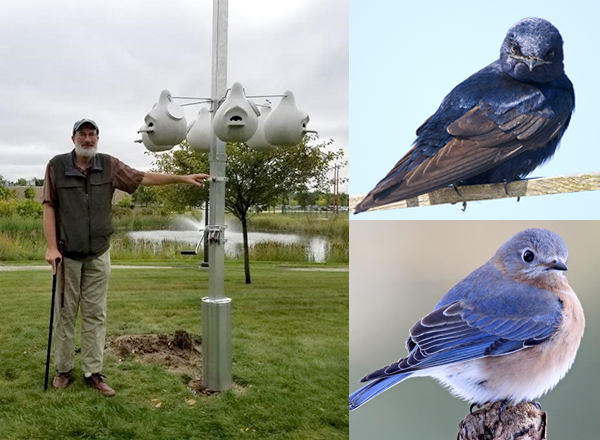“This is for the birds!” Biology instructor makes HFC a bird-friendly campus

This summer, HFC biology instructor Stewart Vining installed purple martin housing, bluebird houses, and bird decals on the HFC campus. The retractable purple martin pole funding was provided by the Michigan State University Extension Michigan SEA Grant, which was secured by Vining. He also purchased and donated bluebird houses. Grounds members Paul Maitland and Rich Kavalar, along with carpenter Don Anson, helped significantly in completing these projects.
Purple martins
Purple martins are highly dependent on human-made housing. The Purple Martin Conservation Association works to educate people and support these birds. Purple martins live near buildings with clear approaches from waterways. Each fall, they migrate to South America. When they return to North America in the spring, they search for gourd housing provided by humans. This habit dates back thousands of years to Native Americans providing purple martins with hanging gourd homes. Some of the greatest threats to purple martins include invasive species, such as the European house sparrow and starlings, which are known for their aggression toward other birds. Bird conservationists work to mitigate these threats.
Making campus a living classroom
Dr. Mary Parekunnel, HFC director of environmental studies, will incorporate service-learning activities related to the new bird housing, helping to make the HFC campus buildings and grounds into a living classroom. Parekunnel earned a scholarship from the Purple Martin Conservation Association, while conducting doctoral research at Canada’s Point Pelee National Park, a migratory bird hub.
The HFC School of STEM (Science, Technology, Engineering, and Mathematics) also houses a large rain and native plant garden with a variety of bird-supporting plants. The garden has recently become a certified wildlife habitat.
Bluebirds
Bluebirds are more solitary than purple martins and tend to avoid human contact. They make their home along forest borders in low-traffic areas. Similar to purple martins, these houses require checkups to make sure house sparrows are not invading the bluebirds' real estate. Vining installed bluebird houses on the west side of the HFC campus near Kingfisher Bluff.
Bird decals
Bird decals were installed on the windows of the Science Building (Bldg. J), where many birds collisions have been noted. The dotted pattern of the decals ensures birds see the windows, preventing bird collisions, while not impairing people's ability to see through the windows. Each year, thousands of birds die in the U.S. from window strikes. The worst of these usually occur in skyscrapers where migrating songbirds are attracted to lights at night. For this reason, Chicago blacks out its entire skyline during peak migration times.
